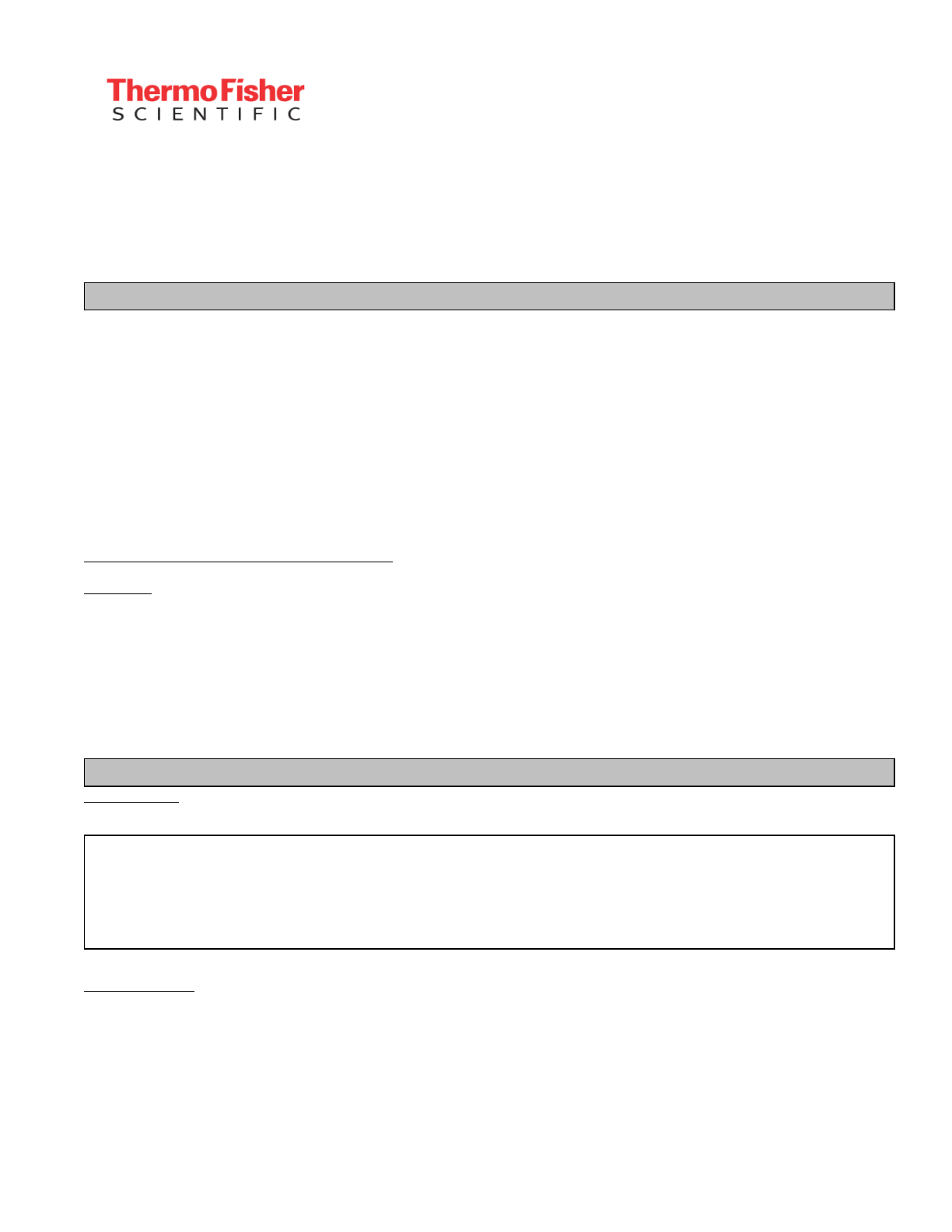
SAFETY DATA SHEET
Creation Date 13-Oct-2009 Revision Date 13-Oct-2023 Revision Number 7
1. Identification
Product Name Ethyl acetate
Cat No. : E195-1; E195-4; E195N1-19; E195N2-19; E195RS-19; E195RS-50;
E195RS-115; E195RS-200; E195SK-1; E195SK-4; E195SK4004;
E195SK4005; E195SK4006; E195SS-19; E195SS-50; E195SS-115;
NC1308052; NC1899880
CAS No
141-78-6
Synonyms
Acetic acid ethyl ester
Recommended Use
Laboratory chemicals.
Uses advised against
Food, drug, pesticide or biocidal product use.
Details of the supplier of the safety data sheet
2. Hazard(s) identification
Classification
This chemical is considered hazardous by the 2012 OSHA Hazard Communication Standard (29 CFR 1910.1200)
Label Elements
Signal Word
Danger
Hazard Statements
Highly flammable liquid and vapor
Company
Fisher Scientific Company
One Reagent Lane
Fair Lawn, NJ 07410
Tel: (201) 796-7100
Emergency Telephone Number
CHEMTRECÒ, Inside the USA: 800-424-9300
CHEMTRECÒ, Outside the USA: 001-703-527-3887
Serious Eye Damage/Eye Irritation Category 2
Specific target organ toxicity (single exposure) Category 3
Target Organs - Central nervous system (CNS).
Flammable liquids Category 2
______________________________________________________________________________________________
Page 1 / 8
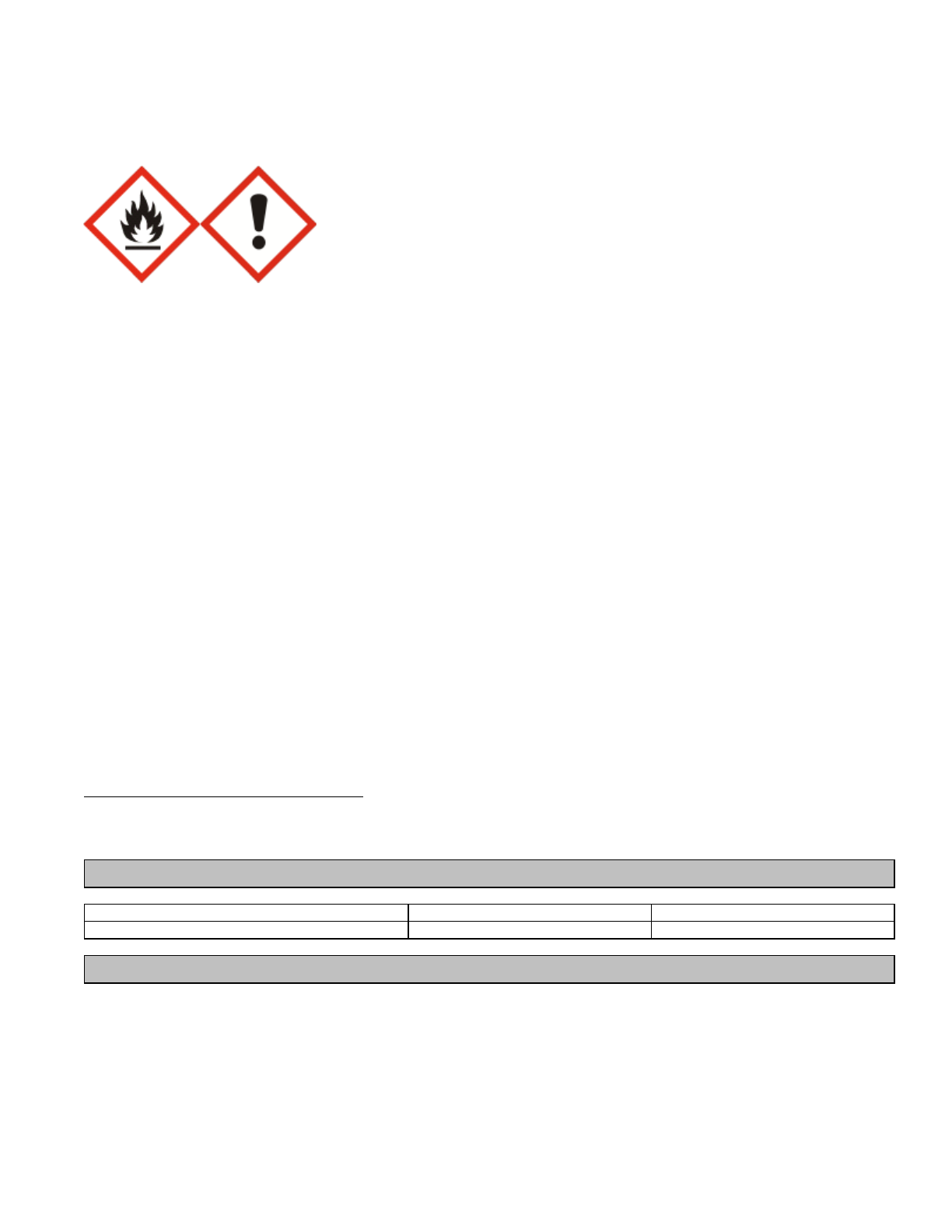
______________________________________________________________________________________________
Ethyl acetate
Revision Date 13-Oct-2023
Causes serious eye irritation
May cause drowsiness or dizziness
Precautionary Statements
Prevention
Wash face, hands and any exposed skin thoroughly after handling
Do not breathe dust/fume/gas/mist/vapors/spray
Use only outdoors or in a well-ventilated area
Keep away from heat/sparks/open flames/hot surfaces. - No smoking
Keep container tightly closed
Ground/bond container and receiving equipment
Use explosion-proof electrical/ventilating/lighting equipment
Use only non-sparking tools
Take precautionary measures against static discharge
Wear protective gloves/protective clothing/eye protection/face protection
Keep cool
Response
Get medical attention/advice if you feel unwell
Inhalation
IF INHALED: Remove victim to fresh air and keep at rest in a position comfortable for breathing
Call a POISON CENTER or doctor/physician if you feel unwell
Skin
IF ON SKIN (or hair): Take off immediately all contaminated clothing. Rinse skin with water/shower
Eyes
IF IN EYES: Rinse cautiously with water for several minutes. Remove contact lenses, if present and easy to do. Continue rinsing
If eye irritation persists: Get medical advice/attention
Fire
In case of fire: Use CO2, dry chemical, or foam for extinction
Storage
Store in a well-ventilated place. Keep container tightly closed
Store locked up
Disposal
Dispose of contents/container to an approved waste disposal plant
Hazards not otherwise classified (HNOC)
Repeated exposure may cause skin dryness or cracking
3. Composition/Information on Ingredients
Component CAS No Weight %
Ethyl acetate 141-78-6 <=100
4. First-aid measures
General Advice
If symptoms persist, call a physician.
Eye Contact
Rinse immediately with plenty of water, also under the eyelids, for at least 15 minutes. Get
medical attention.
______________________________________________________________________________________________
Page 2 / 8

______________________________________________________________________________________________
Ethyl acetate
Revision Date 13-Oct-2023
Skin Contact
Wash off immediately with plenty of water for at least 15 minutes. If skin irritation persists,
call a physician.
Inhalation
Remove to fresh air. If not breathing, give artificial respiration. Get medical attention if
symptoms occur.
Ingestion
Clean mouth with water and drink afterwards plenty of water.
Most important symptoms and
effects
Difficulty in breathing. May cause central nervous system depression: Inhalation of high
vapor concentrations may cause symptoms like headache, dizziness, tiredness, nausea
and vomiting
Notes to Physician
Treat symptomatically
5. Fire-fighting measures
Suitable Extinguishing Media
Water spray, carbon dioxide (CO2), dry chemical, alcohol-resistant foam.
Unsuitable Extinguishing Media
Water may be ineffective, Do not use a solid water stream as it may scatter and spread fire
Flash Point
-4 °C / 24.8 °F
Method -
CC (closed cup)
Autoignition Temperature
427 °C / 800.6 °F
Explosion Limits
Upper
11.5 vol %
Lower
2.0 vol %
Oxidizing Properties
Not oxidising
Sensitivity to Mechanical Impact
No information available
Sensitivity to Static Discharge
No information available
Specific Hazards Arising from the Chemical
Flammable. Risk of ignition. Vapors may form explosive mixtures with air. Vapors may travel to source of ignition and flash back.
Containers may explode when heated.
Hazardous Combustion Products
Carbon monoxide (CO). Carbon dioxide (CO2).
Protective Equipment and Precautions for Firefighters
As in any fire, wear self-contained breathing apparatus pressure-demand, MSHA/NIOSH (approved or equivalent) and full
protective gear.
NFPA
6. Accidental release measures
Personal Precautions
Use personal protective equipment as required. Ensure adequate ventilation.
Environmental Precautions
Should not be released into the environment. See Section 12 for additional Ecological
Information.
Methods for Containment and Clean
Up
Soak up with inert absorbent material. Keep in suitable, closed containers for disposal.
7. Handling and storage
Handling
Ensure adequate ventilation. Wear personal protective equipment/face protection. Do not
get in eyes, on skin, or on clothing. Avoid ingestion and inhalation.
Health
2
Flammability
3
Instability
0
______________________________________________________________________________________________
Page 3 / 8
Physical hazards
N/A

______________________________________________________________________________________________
Ethyl acetate
Revision Date 13-Oct-2023
Storage.
Flammables area. Keep away from heat, sparks and flame. Keep container tightly closed in
a dry and well-ventilated place. Incompatible Materials. Strong oxidizing agents. Strong
acids. Amines. Peroxides.
8. Exposure controls / personal protection
Exposure Guidelines
9. Physical and chemical properties
Physical State
Liquid
Appearance
Colorless
Odor
sweet
Odor Threshold
50 ppm
pH
No information available
Melting Point/Range
-83.5 °C / -118.3 °F
Boiling Point/Range
75 - 78 °C / 167 - 172.4 °F
Flash Point
-4 °C / 24.8 °F
Method -
CC (closed cup)
Evaporation Rate
6.2
Flammability (solid,gas)
Not applicable
Flammability or explosive limits
Upper
11.5 vol %
Lower
2.0 vol %
Vapor Pressure
103 mbar @ 20°C
Vapor Density
3.04
Specific Gravity
0.902
Solubility
Slightly soluble in water
Partition coefficient; n-octanol/water
No data available
Autoignition Temperature
427 °C / 800.6 °F
Decomposition Temperature
No information available
Viscosity
0.45 cP @ 20 °C
Component ACGIH TLV OSHA PEL NIOSH Mexico OEL (TWA)
Ethyl acetate TWA: 400 ppm (Vacated) TWA: 400 ppm
(Vacated) TWA: 1400 mg/m
3
TWA: 400 ppm
TWA: 1400 mg/m
3
IDLH: 2000 ppm
TWA: 400 ppm
TWA: 1400 mg/m
3
TWA: 400 ppm
Legend
ACGIH - American Conference of Governmental Industrial Hygienists
OSHA - Occupational Safety and Health Administration
NIOSH: NIOSH - National Institute for Occupational Safety and Health
Engineering Measures
Ensure adequate ventilation, especially in confined areas. Use explosion-proof
electrical/ventilating/lighting equipment. Ensure that eyewash stations and safety showers
are close to the workstation location.
Personal Protective Equipment
Eye/face Protection
Wear appropriate protective eyeglasses or chemical safety goggles as described by
OSHA's eye and face protection regulations in 29 CFR 1910.133 or European Standard
EN166.
Skin and body protection
Wear appropriate protective gloves and clothing to prevent skin exposure.
Respiratory Protection
No protective equipment is needed under normal use conditions.
Hygiene Measures
______________________________________________________________________________________________
Page 4 / 8
Handle in accordance with good industrial hygiene and safety practice.
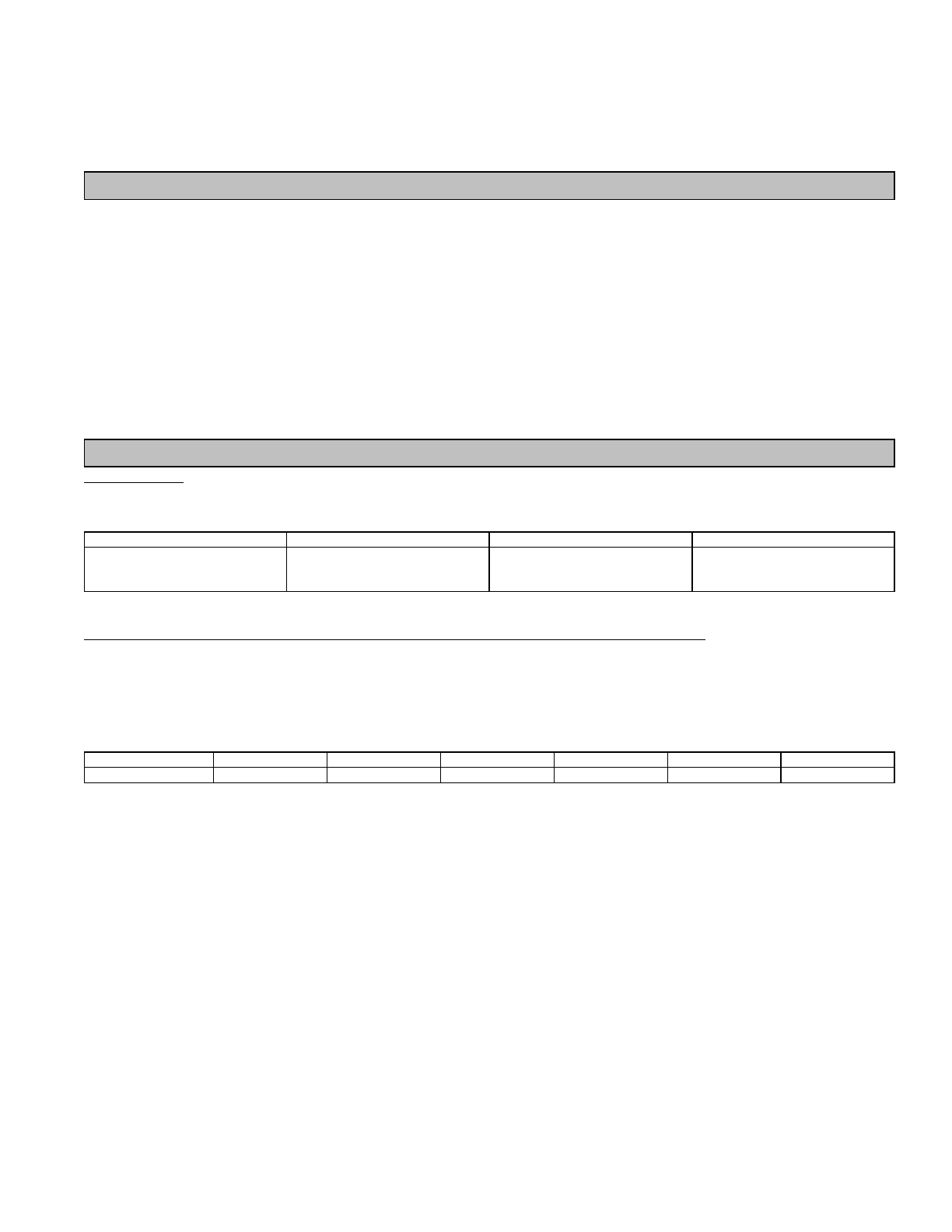
______________________________________________________________________________________________
Ethyl acetate
Revision Date 13-Oct-2023
Molecular Formula
C4 H8 O2
Molecular Weight
88.11
Surface tension
24 mN/m @ 20°C
10. Stability and reactivity
Reactive Hazard
None known, based on information available
Stability
Stable under normal conditions.
Conditions to Avoid
Incompatible products. Keep away from open flames, hot surfaces and sources of ignition.
Incompatible Materials
Strong oxidizing agents, Strong acids, Amines, Peroxides
Hazardous Decomposition Products
Carbon monoxide (CO), Carbon dioxide (CO2)
Hazardous Polymerization
Hazardous polymerization does not occur.
Hazardous Reactions
None under normal processing.
11. Toxicological information
Acute Toxicity
Product Information
Component Information
Component LD50 Oral LD50 Dermal LC50 Inhalation
Ethyl acetate 10,200 mg/kg ( Rat ) > 20 mL/kg ( Rabbit )
> 18000 mg/kg ( Rabbit )
58 mg/l (rat; 8 h)
Toxicologically Synergistic
Products
No information available
Delayed and immediate effects as well as chronic effects from short and long-term exposure
Irritation
Irritating to eyes
Sensitization
No information available
Carcinogenicity
The table below indicates whether each agency has listed any ingredient as a carcinogen.
Component CAS No IARC NTP ACGIH OSHA Mexico
Ethyl acetate 141-78-6 Not listed Not listed Not listed Not listed Not listed
Mutagenic Effects
No information available
Reproductive Effects
No information available.
Developmental Effects
No information available.
Teratogenicity
No information available.
STOT - single exposure
Central nervous system (CNS)
STOT - repeated exposure
None known
Aspiration hazard
No information available
Symptoms / effects,both acute and
delayed
May cause central nervous system depression: Inhalation of high vapor concentrations may
cause symptoms like headache, dizziness, tiredness, nausea and vomiting
Endocrine Disruptor Information
No information available
Other Adverse Effects
The toxicological properties have not been fully investigated.
______________________________________________________________________________________________
Page 5 / 8
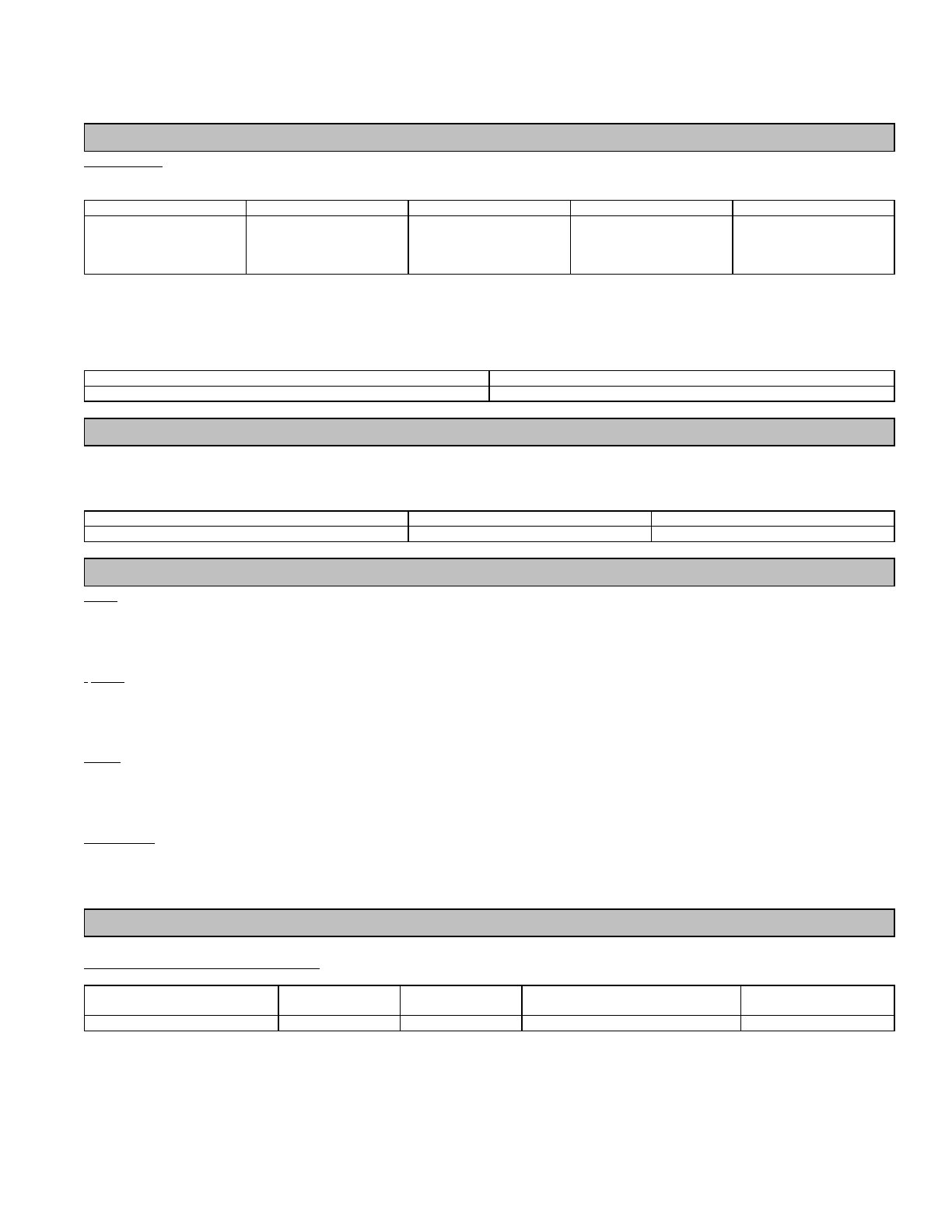
______________________________________________________________________________________________
Ethyl acetate
Revision Date 13-Oct-2023
12. Ecological information
Ecotoxicity
Do not empty into drains.
Component Freshwater Algae Freshwater Fish Microtox Water Flea
Ethyl acetate EC50 = 3300 mg/L/48h Fathead minnow: LC50: 230
mg/l/ 96h
Gold orfe: LC50: 270
mg/L/48h
EC50 = 1180 mg/L 5 min
EC50 = 1500 mg/L 15 min
EC50 = 5870 mg/L 15 min
EC50 = 7400 mg/L 2 h
EC50 = 717 mg/L/48h
Persistence and Degradability
Persistence is unlikely based on information available.
Bioaccumulation/ Accumulation
No information available.
Mobility
Will likely be mobile in the environment due to its volatility.
Component log Pow
Ethyl acetate 0.73
13. Disposal considerations
Waste Disposal Methods
Chemical waste generators must determine whether a discarded chemical is classified as a
hazardous waste. Chemical waste generators must also consult local, regional, and
national hazardous waste regulations to ensure complete and accurate classification.
Component RCRA - U Series Wastes RCRA - P Series Wastes
Ethyl acetate - 141-78-6 U112 -
14. Transport information
DOT
UN-No
UN1173
Proper Shipping Name
ETHYL ACETATE
Hazard Class
3
Packing Group
II
TDG
UN-No
UN1173
Proper Shipping Name
ETHYL ACETATE
Hazard Class
3
Packing Group
II
IATA
UN-No
UN1173
Proper Shipping Name
ETHYL ACETATE
Hazard Class
3
Packing Group
II
IMDG/IMO
UN-No
UN1173
Proper Shipping Name
ETHYL ACETATE
Hazard Class
3
Packing Group
II
15. Regulatory information
United States of America Inventory
Component CAS No TSCA TSCA Inventory notification -
Active-Inactive
TSCA - EPA Regulatory
Flags
Ethyl acetate 141-78-6 X ACTIVE -
Legend:
TSCA US EPA (TSCA) - Toxic Substances Control Act, (40 CFR Part 710)
______________________________________________________________________________________________
Page 6 / 8
X - Listed
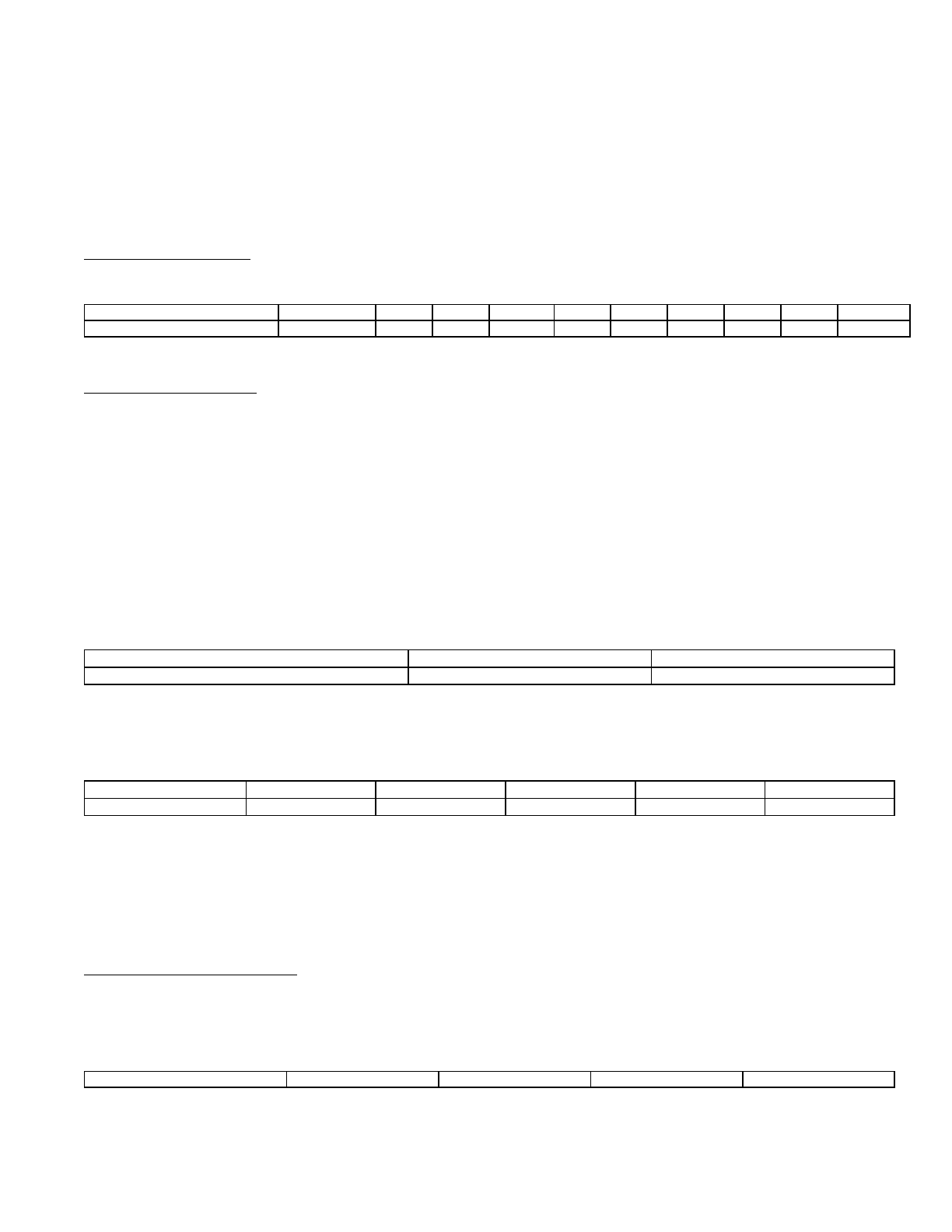
______________________________________________________________________________________________
Ethyl acetate
Revision Date 13-Oct-2023
'-' - Not Listed
TSCA - Per 40 CFR 751, Regulation of Certain Chemical
Substances & Mixtures, Under TSCA Section 6(h) (PBT)
Not applicable
TSCA 12(b) - Notices of Export
Not applicable
International Inventories
Canada (DSL/NDSL), Europe (EINECS/ELINCS/NLP), Philippines (PICCS), Japan (ENCS), Japan (ISHL), Australia (AICS), China (IECSC), Korea
(KECL).
Component CAS No DSL NDSL EINECS PICCS ENCS ISHL AICS IECSC KECL
Ethyl acetate 141-78-6 X - 205-500-4 X X X X X KE-00047
KECL - NIER number or KE number (http://ncis.nier.go.kr/en/main.do)
U.S. Federal Regulations
SARA 313
Not applicable
SARA 311/312 Hazard Categories
See section 2 for more information
CWA (Clean Water Act)
Not applicable
Clean Air Act
Not applicable
OSHA - Occupational Safety and
Health Administration
Not applicable
CERCLA
This material, as supplied, contains one or more substances regulated as a hazardous
substance under the Comprehensive Environmental Response Compensation and Liability
Act (CERCLA) (40 CFR 302)
Component
Hazardous Substances RQs CERCLA EHS RQs
Ethyl acetate
5000 lb -
California Proposition 65
This product does not contain any Proposition 65 chemicals.
U.S. State Right-to-Know
Regulations
Component
Massachusetts New Jersey Pennsylvania Illinois Rhode Island
Ethyl acetate
X X X - X
U.S. Department of Transportation
Reportable Quantity (RQ): Y
DOT Marine Pollutant N
DOT Severe Marine Pollutant N
U.S. Department of Homeland
Security
This product does not contain any DHS chemicals.
Other International Regulations
Mexico - Grade
Serious risk, Grade 3
Authorisation/Restrictions according to EU REACH
Component CAS No REACH (1907/2006) - REACH (1907/2006) - REACH Regulation (EC
______________________________________________________________________________________________
Page 7 / 8

______________________________________________________________________________________________
Ethyl acetate
Revision Date 13-Oct-2023
Annex XIV - Substances
Subject to Authorization
Annex XVII - Restrictions
on Certain Dangerous
Substances
1907/2006) article 59 -
Candidate List of
Substances of Very High
Concern (SVHC)
Ethyl acetate 141-78-6 - Use restricted. See item
75.
(see link for restriction
details)
-
REACH links
https://echa.europa.eu/substances-restricted-under-reach
Safety, health and environmental regulations/legislation specific for the substance or mixture
Component CAS No OECD HPV Persistent Organic
Pollutant
Ozone Depletion
Potential
Restriction of
Hazardous
Substances (RoHS)
Ethyl acetate 141-78-6 Listed Not applicable Not applicable Not applicable
Contains component(s) that meet a 'definition' of per & poly fluoroalkyl substance (PFAS)?
Not applicable
Other International Regulations
Component CAS No Seveso III Directive
(2012/18/EC) -
Qualifying Quantities
for Major Accident
Notification
Seveso III Directive
(2012/18/EC) -
Qualifying Quantities
for Safety Report
Requirements
Rotterdam
Convention (PIC)
Basel Convention
(Hazardous Waste)
Ethyl acetate 141-78-6 Not applicable Not applicable Not applicable Annex I - Y42
16. Other information
Prepared By
Regulatory Affairs
Thermo Fisher Scientific
Email: [email protected]
Creation Date
13-Oct-2009
Revision Date
13-Oct-2023
Print Date
13-Oct-2023
Revision Summary
This document has been updated to comply with the US OSHA HazCom 2012 Standard
replacing the current legislation under 29 CFR 1910.1200 to align with the Globally
Harmonized System of Classification and Labeling of Chemicals (GHS).
Disclaimer
The information provided in this Safety Data Sheet is correct to the best of our knowledge, information and belief at the
date of its publication. The information given is designed only as a guidance for safe handling, use, processing, storage,
transportation, disposal and release and is not to be considered a warranty or quality specification. The information
relates only to the specific material designated and may not be valid for such material used in combination with any other
materials or in any process, unless specified in the text
End of SDS
______________________________________________________________________________________________
Page 8 / 8
